Clownfish are quite possibly the most popular saltwater fish species to grace people's aquariums, which is why so many hobbyists are interested to know which compatible fish will best accompany them! This page contains the top 6 clownfish tank mates in detail, here is a quick summary of them:
- Pygmy Angelfish
- Yellow Tang
- Mandarin Dragonet
- Red Coris Wrasse
- Midas Blenny
- Blue Reef Chromis
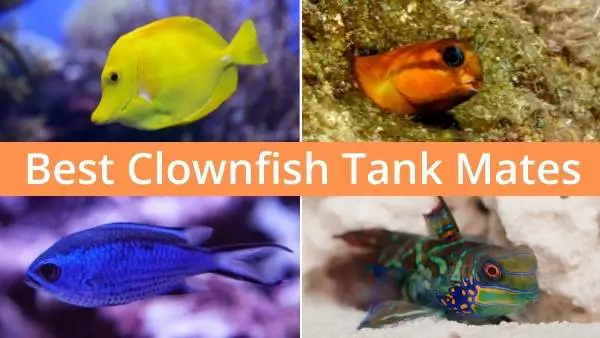
If you are new to fishkeeping, maybe you want to add Clownfish to your community, or even build a saltwater aquarium around Clownfish, if so, knowing what fish are compatible Clownfish tank mates is something you must consider carefully.
The reality is, not all fish can live with Clownfish for one reason or another, and you can potentially create a hostile environment by forcing incompatible fish to live with each other.
Before jumping in, I have provided my video summarizing this exact topic below for a more visual guide:
Clownfish Tank Mate Requirements (Criteria)
The fish that feature on our list are our favorites, which isn't to say that they are going to be yours! Everyone has their own personal taste and preferences when it comes to the fish they want to keep.
So, if you do not like the fish that feature on our list and wish to choose your own clownfish tank mates, you must ensure they fit the criteria below:
- They must be a similar size to clownfish and not big enough to turn your clownfish into a snack.
- Having a similar diet to clownfish will help you out too, although certainly not essential.
- They must share the same temperature requirements as your clownfish, between 75 and 80°F (24 - 27°C).
- It certainly helps if they are also peaceful fish that thrive within community environments.
- Clownfish thrive in aquariums 30 gallons (136 liters) or larger, so, ensure that their tank mates are compatible with this size too.
If you follow this when choosing your own clownfish tank mates, you will do just fine. Now, let's dive into our list!
Clownfish Tank Mates List
Like most species, there are a few different types of Clownfish, ranging in size and behavioral patterns, such as the Tomato Clownfish, Maroon Clownfish, True Percula Clownfish (Amphiprion Percula), Cinnamon Clownfish and the False Percula Clownfish (Ocellaris Clownfish), to name a few.
With the most common types of Clownfish being the (True) Percula Clownfish and the (False) Ocellaris Clownfish, there is a lot of confusion with both types as they look so similar, so it is important when purchasing your own that you find out these subtle yet important differences. Fortunately, there are many different types of Clownfish tank mates for all types of Clownfish, so let's discover what they are.
1. Pygmy Angelfish
Can you put Clownfish with Angelfish? Absolutely yes! Sure, some Angelfish will work better than others, but any type of Angelfish can live happily with all types of Clownfish. Pygmy Angelfish are perhaps the most well-suited to Clownfish due to their size similarities, keeping much larger Angelfish than your Clowns can be problematic as Angelfish can be slightly aggressive.
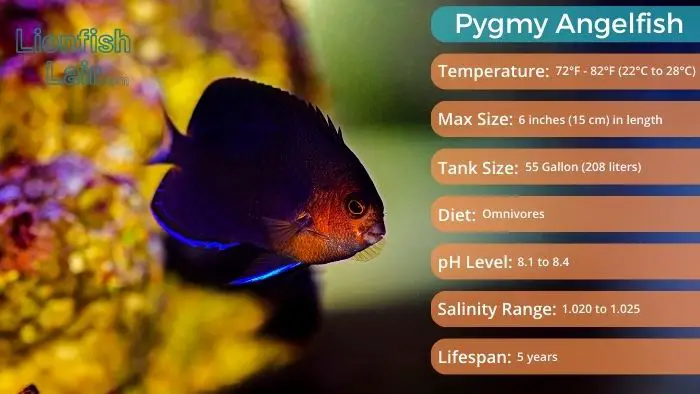
Characteristics Of The Pygmy Angelfish:
- The scientific name is Centropyge.
- They originate from the Indo-Pacific region.
- In terms of numbers, typically dwarf Angelfish do best on their own, although there are many people who have successfully kept them in groups.
- Pygmy Angelfish grow to approximately 4 to 6 inches (10cm - 15cm) in length.
- In terms of temperament, they are peaceful but can become semi-aggressive.
The Pygmy Angelfish feed via grazing, typically eating bryozoans, algae, sponges, and other bacteria and organisms that reside on live rock. The drawback to this is that it makes them not particularly compatible with reef tanks. Their coloration, patterns, and outgoing personalities make them an awesome addition to any Clownfish aquarium.
2. Yellow Tang
Yellow Tang are tremendous little fish that suit almost any reef aquarium environment. They tend to prefer reefs that feature mild turbulence, closely resembling their natural habitat.
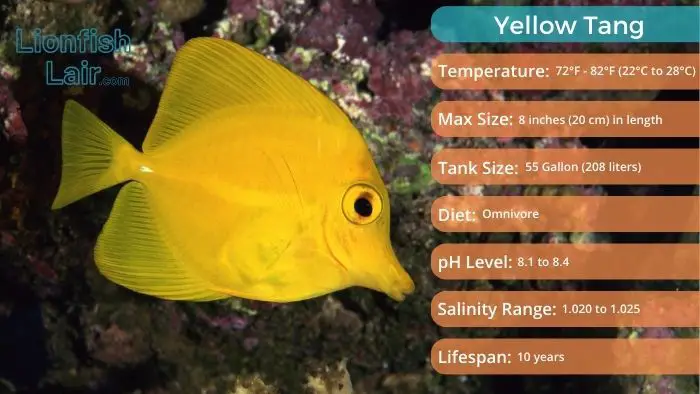
Characteristics Of The Yellow Tang:
- Yellow Tangs will usually live between 5 to 10 years in captivity.
- They tend to swim in schools consisting of 8 to 20 members.
- Their diet consists of dried shrimp, seaweed, algae, and finely sliced vegetables.
- They are prone to ich disease, which is far from ideal but it is certainly preventable and curable.
The Yellow Tang is certainly a sight to behold, and they brighten up any aquarium they are introduced to. Yellow Tangs have always proved to be a good tank mate to the Clownfish. However, like most Tangs, they can become more aggressive after time, but usually it isn't anything to worry about.
3. Mandarin Dragonet
Mandarin Dragonets are tremendously unique and beautiful little fish, they will spend most of their day crawling frantically across your aquarium live rock, seeking food. What makes them such brilliant tank mates for the Clownfish is that they are similarly small fish and tend to occupy different areas of your saltwater tank.
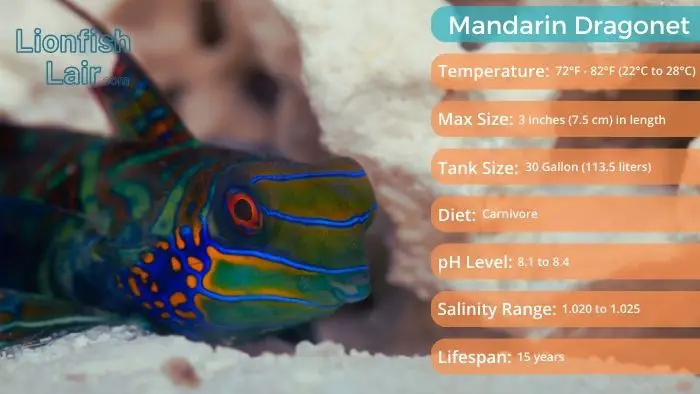
Characteristics Of The Mandarin Dragonet:
- They will usually live between 10 to 15 years.
- The Mandarin Dragonet grows up to 3 inches in length.
- They live off copepods primarily, but also accept Mysis Shrimp, pellets, and Brine Shrimp.
- If you do not have any live rock in your tank, don't bother with these fish as their main diet consists of copepods, commonly found on live rock.
- These Dragonets live best on their own and will thrive in a 30+ gallon tank.
Clownfish and Mandarin Dragonets will live together in relative harmony due to both species not being aggressive fish. These dragonets are truly stunning too, boasting an incredibly unique pattern consisting of bright orange, blue, green, and yellow colors. To learn more about Mandarin Dragonets and everything there is to know about setting up a Mandarin Dragonet tank, make sure to take a look at our specific guide on this.
4. Red Coris Wrasse
Red Coris Wrasses are another fantastic option to accompany your Clownfish, and, unlike some of the other aquarium fish that feature in this list, they can more than handle themselves when housed with the larger, more aggressive species of Clownfish.

Characteristics Of The Red Coris Wrasse:
- They tend to grow to 8 inches in length.
- Red Coris Wrasses will usually live for 2+ years.
- They live off invertebrates and chopped shellfish.
- The Red Coris is the perfect saltwater aquarium fish, compatible with both fish and reef tanks.
- They are peaceful for the most part but can become semi-aggressive over time.
These members of the Wrasse family are truly remarkable-looking fish. They sport a deep-orange body with hundreds if not, thousands of bright blue speckles all over the bottom half of their body. Not only is the coris wrasse a good clownfish tank mate, but clownfish and six line wrasses will get along well too.
5. Midas Blenny
Due to their body shape, general appearance, personalities, and entertaining behavior, Blennies are extremely popular amongst hobbyists at any stage of their journey. They are small and clever little fish that accompany Clownfish brilliantly.
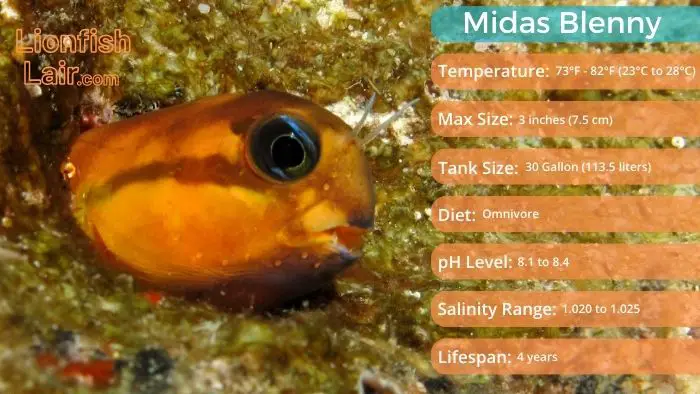
Characteristics Of The Midas Blenny:
- Midas Blennies boast a long and neon-yellow colored body which is a beautiful addition to any aquarium.
- They are small fish, typically growing to around 3 inches in length.
- Their lifespan ranges typically between 2 to 4 years.
- They require a balanced diet of flakes, live, and frozen foods.
- Midas Blennies are some of the most peaceful fish you will likely come across, which makes them perfectly compatible with Clownfish, although, due to their size they can be at risk of being bullied by some of the larger fish.
What makes Blennies so popular is their compatibility with almost any fish and any aquarium environment, as well as their cheap price tag and fascinating behavior. And of course, the fact that they are such beautiful fish.
6. Blue Reef Chromis Damselfish
The last fish to enter our list is the Blue Reef Chromis Damselfish. Funnily enough, clownfish are Damselfish themselves, but both are very different to most fish in under this species. Most Damselfish tend to be territorial and aggressive towards others, but the Blue Reef Chromis are an exception, being naturally peaceful fish.
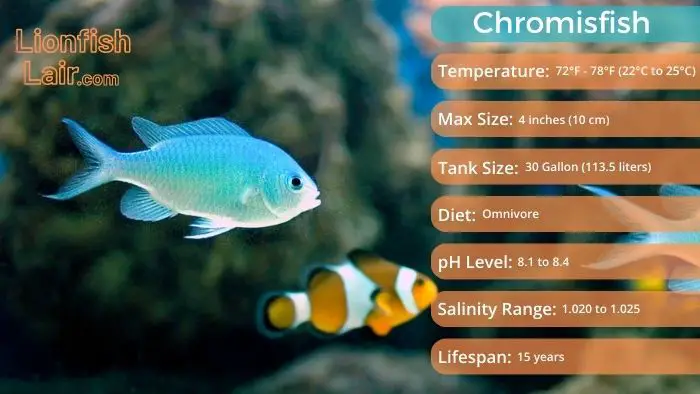
Characteristics Of The Blue Reef Chromis:
- Blue Reef Chromis showcase a beautiful neon blue body that glistens in the light, certainly brightening up any aquarium environment they enter.
- Typically, they will grow to around 4 inches (10 cm) in length, but have been known to get even bigger (5 inches/13 cm) in length.
- They will also live for a long time if they are healthy and have been properly acclimatized - between 8 to 15 years!
- Blue Reef Chromis are omnivores, which means that when they are not feeding on plankton and algae in your tank they will need to be fed a balanced diet consisting of frozen, freeze dried, live foods, and vitamin enriched flakes.
Blue Reef Chromis Damselfish are peaceful fish that are also incredibly active, which helps put some of their less confident tank mates at ease, making them feel safe. They are very hardy too, which is great as the risk of catching disease is minimized.
Bonus Tank Mate: Sea Anemone
When you think of Clownfish and more specifically Clownfish compatibility, it is hard not to look at the relationship between Clownfish and Sea Anemones. Anemones provide unique protection for Clownfish with their stinging tentacles, and in return, Clownfish protect them and also provide Anemones with food.
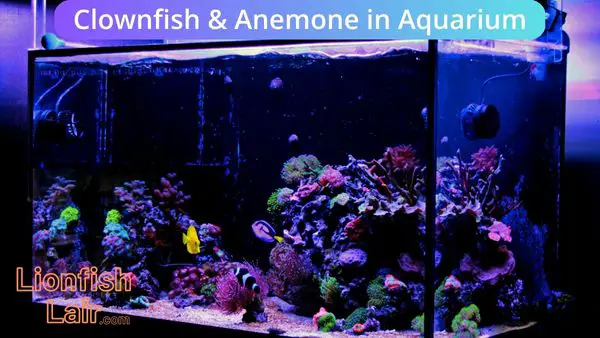
For hobbyists and aquarium owners, acquiring a Sea Anemone is no easy task, and more importantly, meeting their light and water requirements is even more difficult. So, despite this article only listing fish tank mates, it makes sense to list all the compatible Anemones too, as they will be your Clownfish's potential home. Another interesting and beautiful partnership is the clownfish and royal gramma.
Not all Anemones will host Clownfish, but the Anemones below do:
- Adhesive Sea Anemone (Cryptodendrum adhaesivum)
- Bubble Tip Anemone (Entacmaea quadricolor)
- Beaded Sea Anemone (Heteractis aurora)
- Sebae Anemone (Heteractis crispa)
- Magnificent Sea Anemone (Heteractis magnifica)
- Delicate Sea Anemone (Heteractis malu)
- Long Tentacle Anemone (Macrodactyla doreensis)
- Giant Carpet Anemone (Stichodactyla gigantea)
- Saddle Carpet Anemone (Stichodactyla haddoni)
- Merten's Carpet Anemone (Stichodactyla mertensii)
Top 5 Clownfish Tank Mates - Free Downloadable PDF
If you have enjoyed our advisories on clownfish tank mates, make sure to download a free PDF consisting of the top 5 tank mates from this list!
It can be rather time-consuming to have to sift through an article just to find what you are looking for, which is why we have created a visual and colorful PDF guide to our top 5 clownfish tank mates for you to either download or print out and use as a physical reference going forward, enjoy!
Clownfish Tank Mates FAQs
Now that we have covered the top 6 clownfish tank mates and what fish can live with clownfish, we will now answer some of the most commonly asked questions on this subject.
Can You Mix Clownfish With Other Clownfish?
Yes, you can, however, do so at your own risk as they will probably end up fighting with each other. Unfortunately, having multiple clownfish, even if they are the exact same subspecies will often lead to a pair becoming the dominant force, bullying and chasing around the other clownfish, which is more prominent when you mix one clownfish species with another. This typically results in stressed out clownfish, which is never good!
Can Clownfish Live With Guppies?
Absolutely not, clownfish are saltwater fish that require certain levels of salinity in their water in order to breathe and ultimately, survive, whereas guppies are freshwater fish. Unfortunately, although they would make an asthetically pleasing pair, both clownfish and guppies are not compatible tank mates and should never be placed in the same tank as each other.
How Many Clownfish Should Be Kept Together?
It is widely known that you should only keep a maximum of two clownfish together. They might play nice with other fish species, but if there are more than 2 clownfish together, expect a lot of fighting, which will lead to a multitude of problems.
Conclusion
Clownfish are fascinating fish, and it is understandable why they are so unbelievably popular. They are perfect fish for beginner and expert hobbyists alike due to their generally peaceful nature and low maintenance when it comes to Clownfish tank setup. Additionally, whilst Clownfish can live alone, Clownfish are also good tank mates for Clownfish! One of the best ways of creating a clownfish community in your aquarium is by breeding them!
It is so important to remember that before you purchase any new fish that you conduct the correct research into compatible tank mates.

